1994 JEEP CHEROKEE torque
[x] Cancel search: torquePage 1638 of 1784
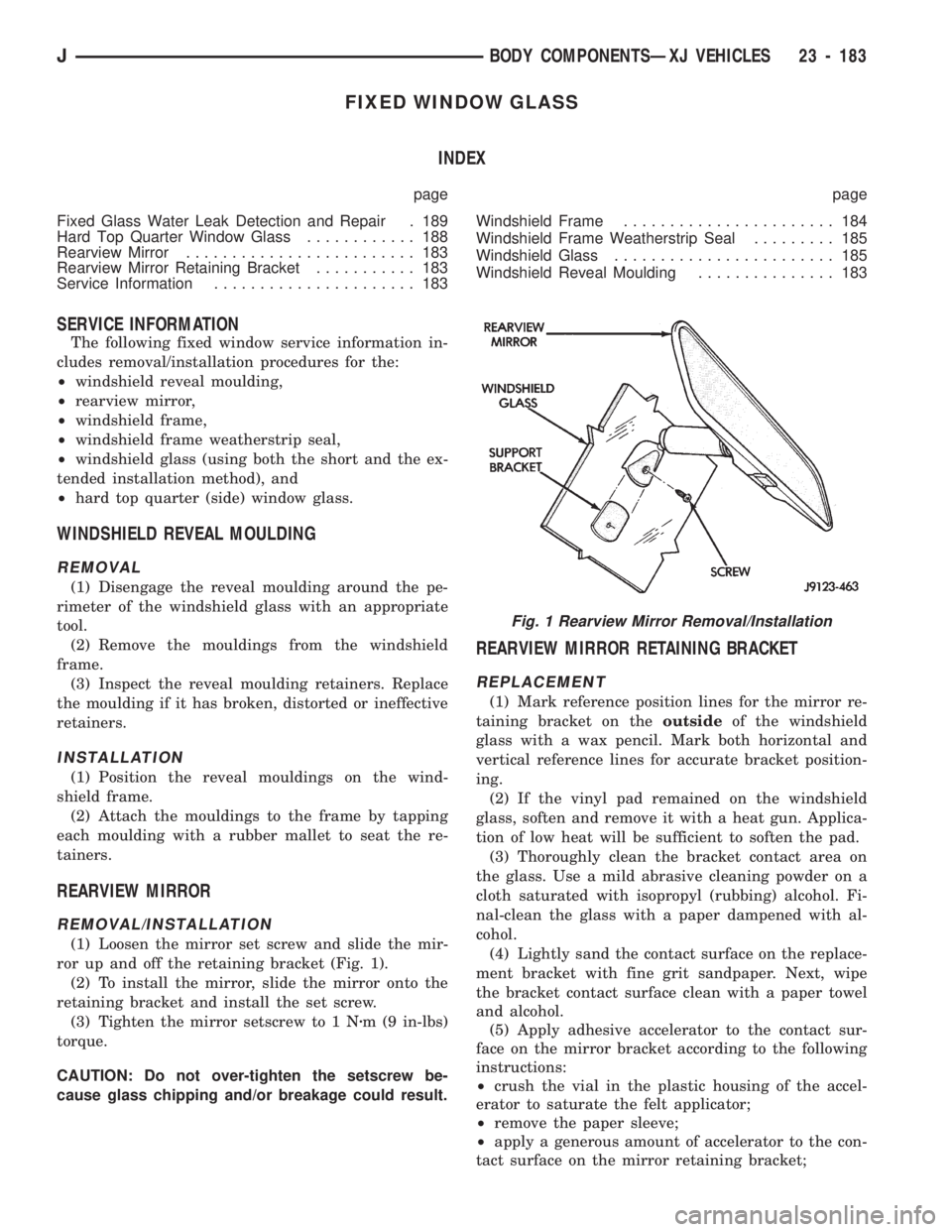
FIXED WINDOW GLASS
INDEX
page page
Fixed Glass Water Leak Detection and Repair . 189
Hard Top Quarter Window Glass............ 188
Rearview Mirror......................... 183
Rearview Mirror Retaining Bracket........... 183
Service Information...................... 183Windshield Frame....................... 184
Windshield Frame Weatherstrip Seal......... 185
Windshield Glass........................ 185
Windshield Reveal Moulding............... 183
SERVICE INFORMATION
The following fixed window service information in-
cludes removal/installation procedures for the:
²windshield reveal moulding,
²rearview mirror,
²windshield frame,
²windshield frame weatherstrip seal,
²windshield glass (using both the short and the ex-
tended installation method), and
²hard top quarter (side) window glass.
WINDSHIELD REVEAL MOULDING
REMOVAL
(1) Disengage the reveal moulding around the pe-
rimeter of the windshield glass with an appropriate
tool.
(2) Remove the mouldings from the windshield
frame.
(3) Inspect the reveal moulding retainers. Replace
the moulding if it has broken, distorted or ineffective
retainers.
INSTALLATION
(1) Position the reveal mouldings on the wind-
shield frame.
(2) Attach the mouldings to the frame by tapping
each moulding with a rubber mallet to seat the re-
tainers.
REARVIEW MIRROR
REMOVAL/INSTALLATION
(1) Loosen the mirror set screw and slide the mir-
ror up and off the retaining bracket (Fig. 1).
(2) To install the mirror, slide the mirror onto the
retaining bracket and install the set screw.
(3) Tighten the mirror setscrew to 1 Nzm (9 in-lbs)
torque.
CAUTION: Do not over-tighten the setscrew be-
cause glass chipping and/or breakage could result.
REARVIEW MIRROR RETAINING BRACKET
REPLACEMENT
(1) Mark reference position lines for the mirror re-
taining bracket on theoutsideof the windshield
glass with a wax pencil. Mark both horizontal and
vertical reference lines for accurate bracket position-
ing.
(2) If the vinyl pad remained on the windshield
glass, soften and remove it with a heat gun. Applica-
tion of low heat will be sufficient to soften the pad.
(3) Thoroughly clean the bracket contact area on
the glass. Use a mild abrasive cleaning powder on a
cloth saturated with isopropyl (rubbing) alcohol. Fi-
nal-clean the glass with a paper dampened with al-
cohol.
(4) Lightly sand the contact surface on the replace-
ment bracket with fine grit sandpaper. Next, wipe
the bracket contact surface clean with a paper towel
and alcohol.
(5) Apply adhesive accelerator to the contact sur-
face on the mirror bracket according to the following
instructions:
²crush the vial in the plastic housing of the accel-
erator to saturate the felt applicator;
²remove the paper sleeve;
²apply a generous amount of accelerator to the con-
tact surface on the mirror retaining bracket;
Fig. 1 Rearview Mirror Removal/Installation
JBODY COMPONENTSÐXJ VEHICLES 23 - 183
Page 1642 of 1784
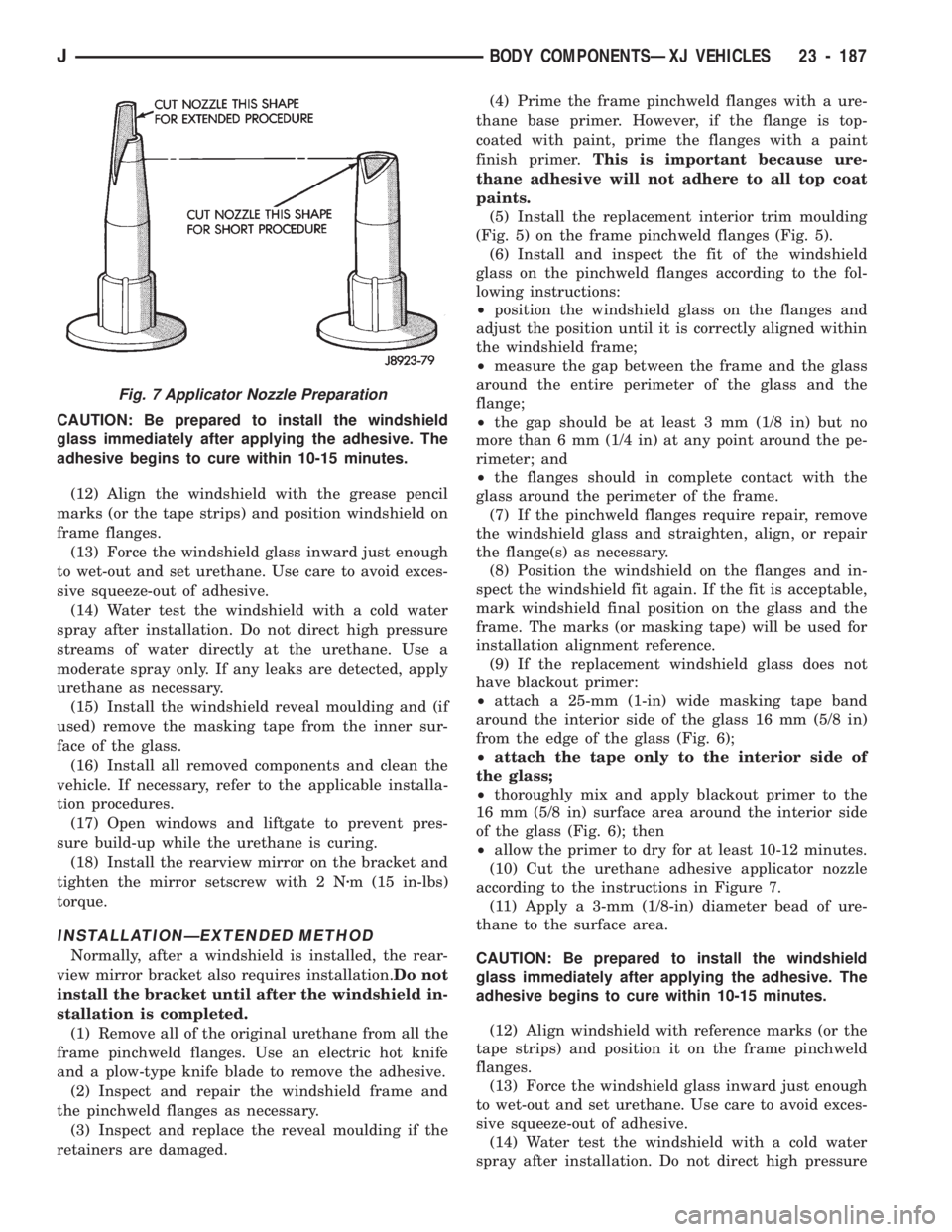
CAUTION: Be prepared to install the windshield
glass immediately after applying the adhesive. The
adhesive begins to cure within 10-15 minutes.
(12) Align the windshield with the grease pencil
marks (or the tape strips) and position windshield on
frame flanges.
(13) Force the windshield glass inward just enough
to wet-out and set urethane. Use care to avoid exces-
sive squeeze-out of adhesive.
(14) Water test the windshield with a cold water
spray after installation. Do not direct high pressure
streams of water directly at the urethane. Use a
moderate spray only. If any leaks are detected, apply
urethane as necessary.
(15) Install the windshield reveal moulding and (if
used) remove the masking tape from the inner sur-
face of the glass.
(16) Install all removed components and clean the
vehicle. If necessary, refer to the applicable installa-
tion procedures.
(17) Open windows and liftgate to prevent pres-
sure build-up while the urethane is curing.
(18) Install the rearview mirror on the bracket and
tighten the mirror setscrew with 2 Nzm (15 in-lbs)
torque.
INSTALLATIONÐEXTENDED METHOD
Normally, after a windshield is installed, the rear-
view mirror bracket also requires installation.Do not
install the bracket until after the windshield in-
stallation is completed.
(1) Remove all of the original urethane from all the
frame pinchweld flanges. Use an electric hot knife
and a plow-type knife blade to remove the adhesive.
(2) Inspect and repair the windshield frame and
the pinchweld flanges as necessary.
(3) Inspect and replace the reveal moulding if the
retainers are damaged.(4) Prime the frame pinchweld flanges with a ure-
thane base primer. However, if the flange is top-
coated with paint, prime the flanges with a paint
finish primer.This is important because ure-
thane adhesive will not adhere to all top coat
paints.
(5) Install the replacement interior trim moulding
(Fig. 5) on the frame pinchweld flanges (Fig. 5).
(6) Install and inspect the fit of the windshield
glass on the pinchweld flanges according to the fol-
lowing instructions:
²position the windshield glass on the flanges and
adjust the position until it is correctly aligned within
the windshield frame;
²measure the gap between the frame and the glass
around the entire perimeter of the glass and the
flange;
²the gap should be at least 3 mm (1/8 in) but no
more than 6 mm (1/4 in) at any point around the pe-
rimeter; and
²the flanges should in complete contact with the
glass around the perimeter of the frame.
(7) If the pinchweld flanges require repair, remove
the windshield glass and straighten, align, or repair
the flange(s) as necessary.
(8) Position the windshield on the flanges and in-
spect the windshield fit again. If the fit is acceptable,
mark windshield final position on the glass and the
frame. The marks (or masking tape) will be used for
installation alignment reference.
(9) If the replacement windshield glass does not
have blackout primer:
²attach a 25-mm (1-in) wide masking tape band
around the interior side of the glass 16 mm (5/8 in)
from the edge of the glass (Fig. 6);
²attach the tape only to the interior side of
the glass;
²thoroughly mix and apply blackout primer to the
16 mm (5/8 in) surface area around the interior side
of the glass (Fig. 6); then
²allow the primer to dry for at least 10-12 minutes.
(10) Cut the urethane adhesive applicator nozzle
according to the instructions in Figure 7.
(11) Apply a 3-mm (1/8-in) diameter bead of ure-
thane to the surface area.
CAUTION: Be prepared to install the windshield
glass immediately after applying the adhesive. The
adhesive begins to cure within 10-15 minutes.
(12) Align windshield with reference marks (or the
tape strips) and position it on the frame pinchweld
flanges.
(13) Force the windshield glass inward just enough
to wet-out and set urethane. Use care to avoid exces-
sive squeeze-out of adhesive.
(14) Water test the windshield with a cold water
spray after installation. Do not direct high pressure
Fig. 7 Applicator Nozzle Preparation
JBODY COMPONENTSÐXJ VEHICLES 23 - 187
Page 1643 of 1784
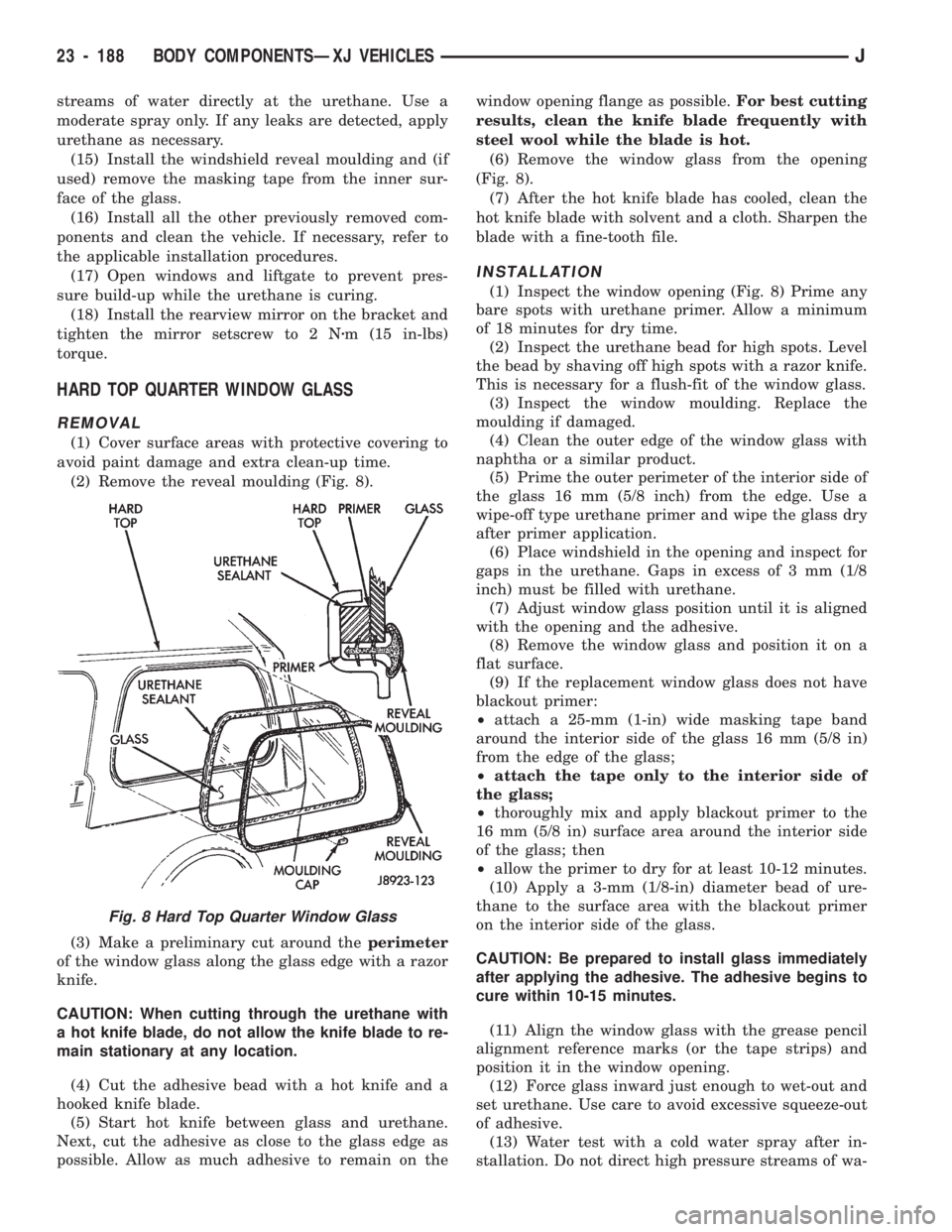
streams of water directly at the urethane. Use a
moderate spray only. If any leaks are detected, apply
urethane as necessary.
(15) Install the windshield reveal moulding and (if
used) remove the masking tape from the inner sur-
face of the glass.
(16) Install all the other previously removed com-
ponents and clean the vehicle. If necessary, refer to
the applicable installation procedures.
(17) Open windows and liftgate to prevent pres-
sure build-up while the urethane is curing.
(18) Install the rearview mirror on the bracket and
tighten the mirror setscrew to 2 Nzm (15 in-lbs)
torque.
HARD TOP QUARTER WINDOW GLASS
REMOVAL
(1) Cover surface areas with protective covering to
avoid paint damage and extra clean-up time.
(2) Remove the reveal moulding (Fig. 8).
(3) Make a preliminary cut around theperimeter
of the window glass along the glass edge with a razor
knife.
CAUTION: When cutting through the urethane with
a hot knife blade, do not allow the knife blade to re-
main stationary at any location.
(4) Cut the adhesive bead with a hot knife and a
hooked knife blade.
(5) Start hot knife between glass and urethane.
Next, cut the adhesive as close to the glass edge as
possible. Allow as much adhesive to remain on thewindow opening flange as possible.For best cutting
results, clean the knife blade frequently with
steel wool while the blade is hot.
(6) Remove the window glass from the opening
(Fig. 8).
(7) After the hot knife blade has cooled, clean the
hot knife blade with solvent and a cloth. Sharpen the
blade with a fine-tooth file.
INSTALLATION
(1) Inspect the window opening (Fig. 8) Prime any
bare spots with urethane primer. Allow a minimum
of 18 minutes for dry time.
(2) Inspect the urethane bead for high spots. Level
the bead by shaving off high spots with a razor knife.
This is necessary for a flush-fit of the window glass.
(3) Inspect the window moulding. Replace the
moulding if damaged.
(4) Clean the outer edge of the window glass with
naphtha or a similar product.
(5) Prime the outer perimeter of the interior side of
the glass 16 mm (5/8 inch) from the edge. Use a
wipe-off type urethane primer and wipe the glass dry
after primer application.
(6) Place windshield in the opening and inspect for
gaps in the urethane. Gaps in excess of 3 mm (1/8
inch) must be filled with urethane.
(7) Adjust window glass position until it is aligned
with the opening and the adhesive.
(8) Remove the window glass and position it on a
flat surface.
(9) If the replacement window glass does not have
blackout primer:
²attach a 25-mm (1-in) wide masking tape band
around the interior side of the glass 16 mm (5/8 in)
from the edge of the glass;
²attach the tape only to the interior side of
the glass;
²thoroughly mix and apply blackout primer to the
16 mm (5/8 in) surface area around the interior side
of the glass; then
²allow the primer to dry for at least 10-12 minutes.
(10) Apply a 3-mm (1/8-in) diameter bead of ure-
thane to the surface area with the blackout primer
on the interior side of the glass.
CAUTION: Be prepared to install glass immediately
after applying the adhesive. The adhesive begins to
cure within 10-15 minutes.
(11) Align the window glass with the grease pencil
alignment reference marks (or the tape strips) and
position it in the window opening.
(12) Force glass inward just enough to wet-out and
set urethane. Use care to avoid excessive squeeze-out
of adhesive.
(13) Water test with a cold water spray after in-
stallation. Do not direct high pressure streams of wa-
Fig. 8 Hard Top Quarter Window Glass
23 - 188 BODY COMPONENTSÐXJ VEHICLESJ
Page 1645 of 1784
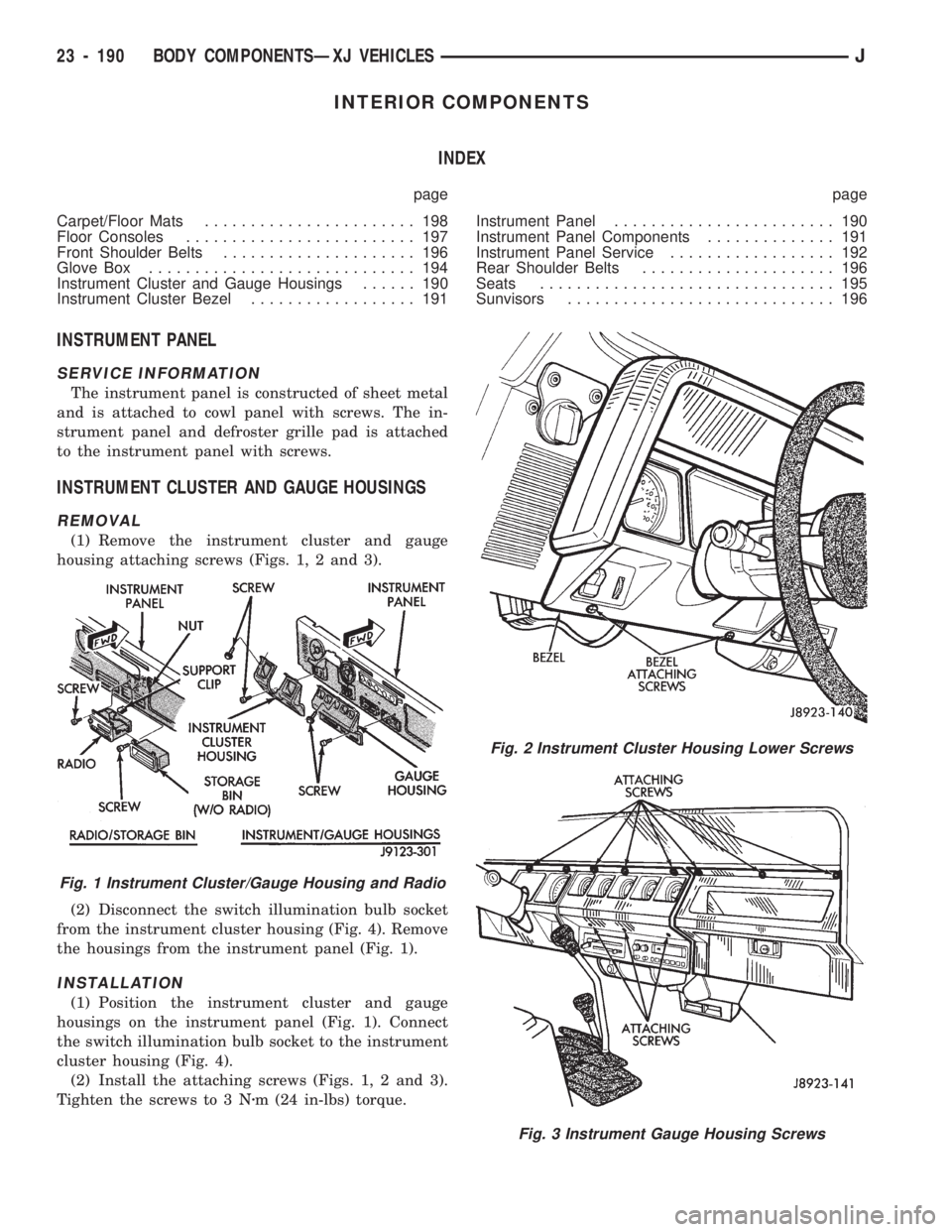
INTERIOR COMPONENTS
INDEX
page page
Carpet/Floor Mats....................... 198
Floor Consoles......................... 197
Front Shoulder Belts..................... 196
Glove Box............................. 194
Instrument Cluster and Gauge Housings...... 190
Instrument Cluster Bezel.................. 191Instrument Panel........................ 190
Instrument Panel Components.............. 191
Instrument Panel Service.................. 192
Rear Shoulder Belts..................... 196
Seats................................ 195
Sunvisors............................. 196
INSTRUMENT PANEL
SERVICE INFORMATION
The instrument panel is constructed of sheet metal
and is attached to cowl panel with screws. The in-
strument panel and defroster grille pad is attached
to the instrument panel with screws.
INSTRUMENT CLUSTER AND GAUGE HOUSINGS
REMOVAL
(1) Remove the instrument cluster and gauge
housing attaching screws (Figs. 1, 2 and 3).
(2) Disconnect the switch illumination bulb socket
from the instrument cluster housing (Fig. 4). Remove
the housings from the instrument panel (Fig. 1).
INSTALLATION
(1) Position the instrument cluster and gauge
housings on the instrument panel (Fig. 1). Connect
the switch illumination bulb socket to the instrument
cluster housing (Fig. 4).
(2) Install the attaching screws (Figs. 1, 2 and 3).
Tighten the screws to 3 Nzm (24 in-lbs) torque.
Fig. 2 Instrument Cluster Housing Lower Screws
Fig. 3 Instrument Gauge Housing Screws
Fig. 1 Instrument Cluster/Gauge Housing and Radio
23 - 190 BODY COMPONENTSÐXJ VEHICLESJ
Page 1646 of 1784
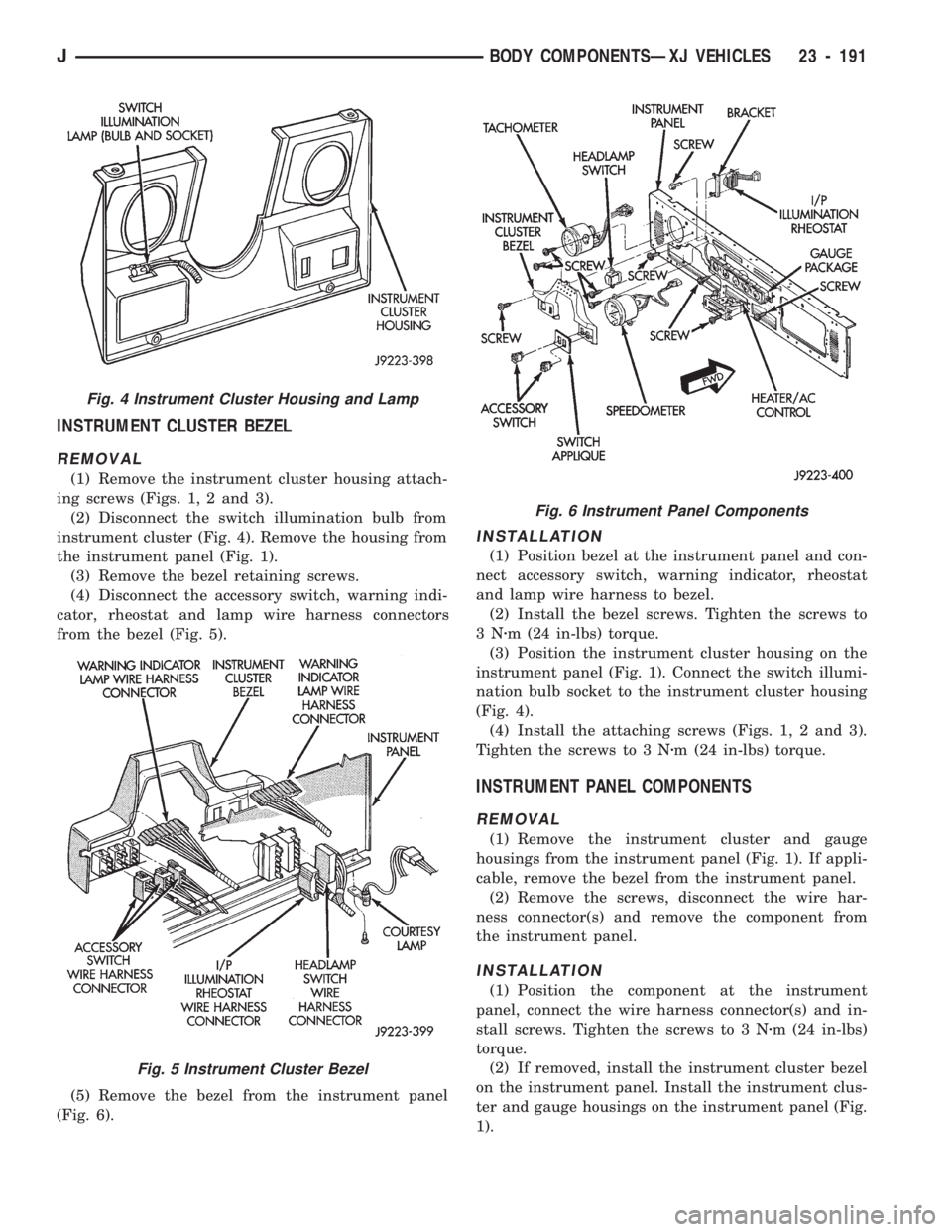
INSTRUMENT CLUSTER BEZEL
REMOVAL
(1) Remove the instrument cluster housing attach-
ing screws (Figs. 1, 2 and 3).
(2) Disconnect the switch illumination bulb from
instrument cluster (Fig. 4). Remove the housing from
the instrument panel (Fig. 1).
(3) Remove the bezel retaining screws.
(4) Disconnect the accessory switch, warning indi-
cator, rheostat and lamp wire harness connectors
from the bezel (Fig. 5).
(5) Remove the bezel from the instrument panel
(Fig. 6).
INSTALLATION
(1) Position bezel at the instrument panel and con-
nect accessory switch, warning indicator, rheostat
and lamp wire harness to bezel.
(2) Install the bezel screws. Tighten the screws to
3Nzm (24 in-lbs) torque.
(3) Position the instrument cluster housing on the
instrument panel (Fig. 1). Connect the switch illumi-
nation bulb socket to the instrument cluster housing
(Fig. 4).
(4) Install the attaching screws (Figs. 1, 2 and 3).
Tighten the screws to 3 Nzm (24 in-lbs) torque.
INSTRUMENT PANEL COMPONENTS
REMOVAL
(1) Remove the instrument cluster and gauge
housings from the instrument panel (Fig. 1). If appli-
cable, remove the bezel from the instrument panel.
(2) Remove the screws, disconnect the wire har-
ness connector(s) and remove the component from
the instrument panel.
INSTALLATION
(1) Position the component at the instrument
panel, connect the wire harness connector(s) and in-
stall screws. Tighten the screws to 3 Nzm (24 in-lbs)
torque.
(2) If removed, install the instrument cluster bezel
on the instrument panel. Install the instrument clus-
ter and gauge housings on the instrument panel (Fig.
1).
Fig. 4 Instrument Cluster Housing and Lamp
Fig. 5 Instrument Cluster Bezel
Fig. 6 Instrument Panel Components
JBODY COMPONENTSÐXJ VEHICLES 23 - 191
Page 1649 of 1784
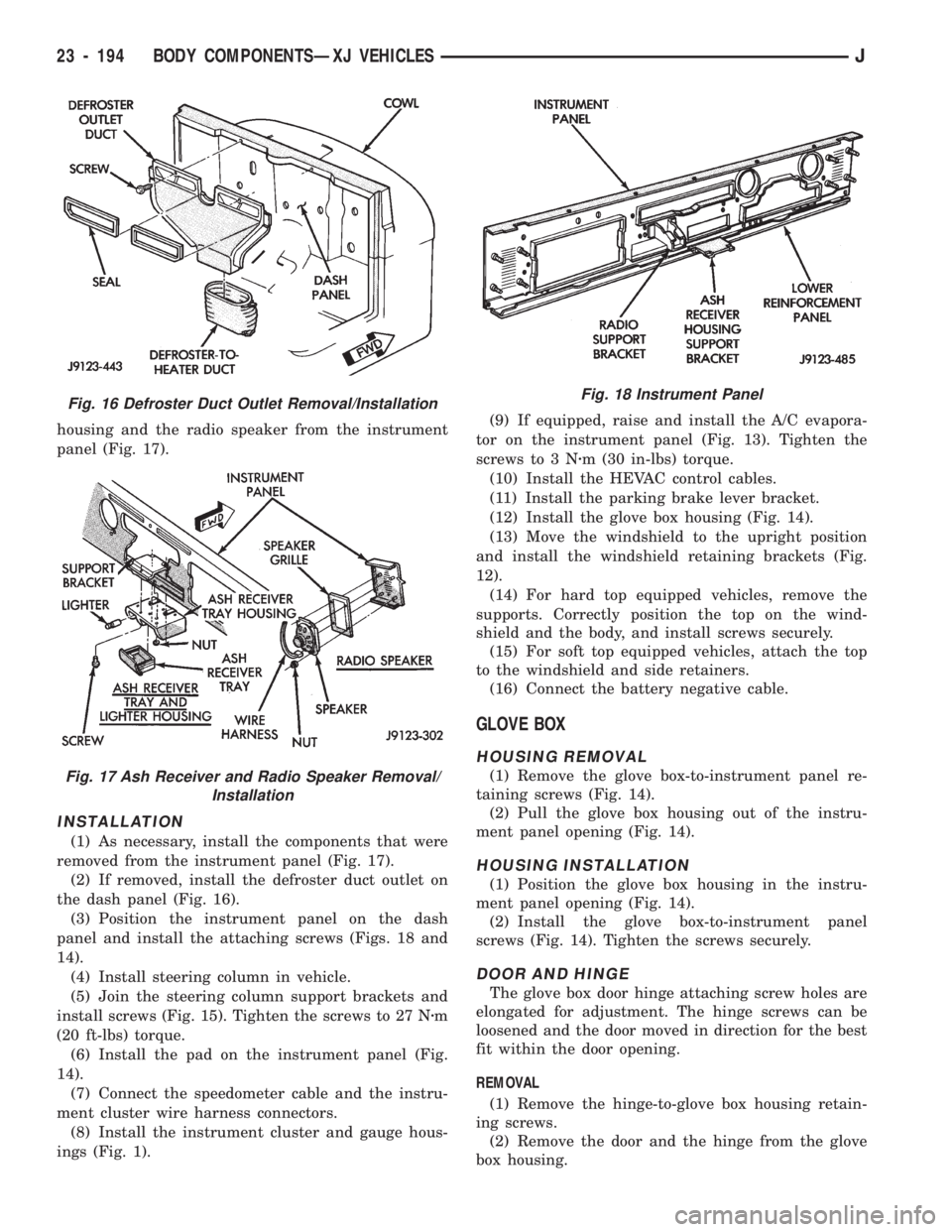
housing and the radio speaker from the instrument
panel (Fig. 17).
INSTALLATION
(1) As necessary, install the components that were
removed from the instrument panel (Fig. 17).
(2) If removed, install the defroster duct outlet on
the dash panel (Fig. 16).
(3) Position the instrument panel on the dash
panel and install the attaching screws (Figs. 18 and
14).
(4) Install steering column in vehicle.
(5) Join the steering column support brackets and
install screws (Fig. 15). Tighten the screws to 27 Nzm
(20 ft-lbs) torque.
(6) Install the pad on the instrument panel (Fig.
14).
(7) Connect the speedometer cable and the instru-
ment cluster wire harness connectors.
(8) Install the instrument cluster and gauge hous-
ings (Fig. 1).(9) If equipped, raise and install the A/C evapora-
tor on the instrument panel (Fig. 13). Tighten the
screws to 3 Nzm (30 in-lbs) torque.
(10) Install the HEVAC control cables.
(11) Install the parking brake lever bracket.
(12) Install the glove box housing (Fig. 14).
(13) Move the windshield to the upright position
and install the windshield retaining brackets (Fig.
12).
(14) For hard top equipped vehicles, remove the
supports. Correctly position the top on the wind-
shield and the body, and install screws securely.
(15) For soft top equipped vehicles, attach the top
to the windshield and side retainers.
(16) Connect the battery negative cable.
GLOVE BOX
HOUSING REMOVAL
(1) Remove the glove box-to-instrument panel re-
taining screws (Fig. 14).
(2) Pull the glove box housing out of the instru-
ment panel opening (Fig. 14).
HOUSING INSTALLATION
(1) Position the glove box housing in the instru-
ment panel opening (Fig. 14).
(2) Install the glove box-to-instrument panel
screws (Fig. 14). Tighten the screws securely.
DOOR AND HINGE
The glove box door hinge attaching screw holes are
elongated for adjustment. The hinge screws can be
loosened and the door moved in direction for the best
fit within the door opening.
REMOVAL
(1) Remove the hinge-to-glove box housing retain-
ing screws.
(2) Remove the door and the hinge from the glove
box housing.
Fig. 16 Defroster Duct Outlet Removal/Installation
Fig. 17 Ash Receiver and Radio Speaker Removal/
Installation
Fig. 18 Instrument Panel
23 - 194 BODY COMPONENTSÐXJ VEHICLESJ
Page 1651 of 1784
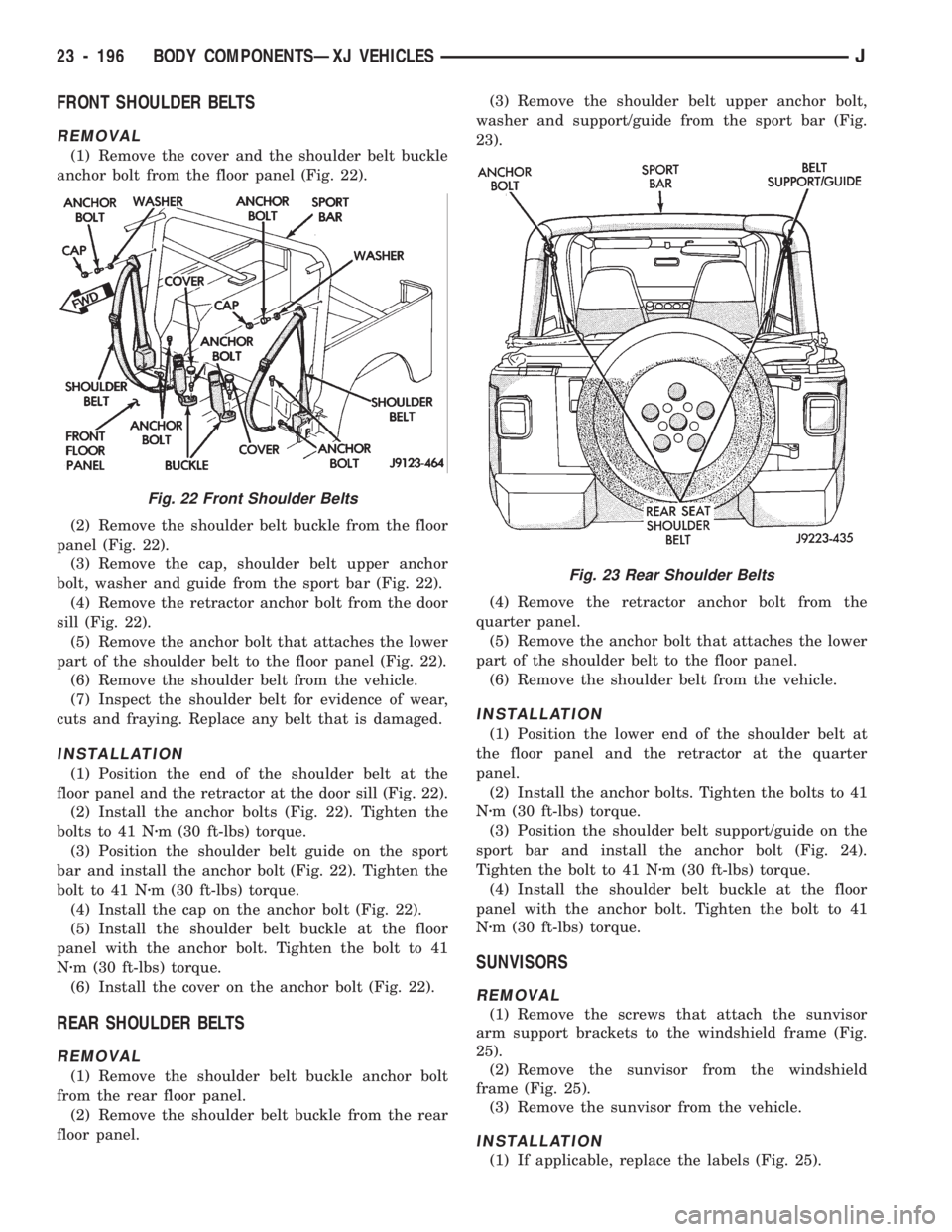
FRONT SHOULDER BELTS
REMOVAL
(1) Remove the cover and the shoulder belt buckle
anchor bolt from the floor panel (Fig. 22).
(2) Remove the shoulder belt buckle from the floor
panel (Fig. 22).
(3) Remove the cap, shoulder belt upper anchor
bolt, washer and guide from the sport bar (Fig. 22).
(4) Remove the retractor anchor bolt from the door
sill (Fig. 22).
(5) Remove the anchor bolt that attaches the lower
part of the shoulder belt to the floor panel (Fig. 22).
(6) Remove the shoulder belt from the vehicle.
(7) Inspect the shoulder belt for evidence of wear,
cuts and fraying. Replace any belt that is damaged.
INSTALLATION
(1) Position the end of the shoulder belt at the
floor panel and the retractor at the door sill (Fig. 22).
(2) Install the anchor bolts (Fig. 22). Tighten the
bolts to 41 Nzm (30 ft-lbs) torque.
(3) Position the shoulder belt guide on the sport
bar and install the anchor bolt (Fig. 22). Tighten the
bolt to 41 Nzm (30 ft-lbs) torque.
(4) Install the cap on the anchor bolt (Fig. 22).
(5) Install the shoulder belt buckle at the floor
panel with the anchor bolt. Tighten the bolt to 41
Nzm (30 ft-lbs) torque.
(6) Install the cover on the anchor bolt (Fig. 22).
REAR SHOULDER BELTS
REMOVAL
(1) Remove the shoulder belt buckle anchor bolt
from the rear floor panel.
(2) Remove the shoulder belt buckle from the rear
floor panel.(3) Remove the shoulder belt upper anchor bolt,
washer and support/guide from the sport bar (Fig.
23).
(4) Remove the retractor anchor bolt from the
quarter panel.
(5) Remove the anchor bolt that attaches the lower
part of the shoulder belt to the floor panel.
(6) Remove the shoulder belt from the vehicle.
INSTALLATION
(1) Position the lower end of the shoulder belt at
the floor panel and the retractor at the quarter
panel.
(2) Install the anchor bolts. Tighten the bolts to 41
Nzm (30 ft-lbs) torque.
(3) Position the shoulder belt support/guide on the
sport bar and install the anchor bolt (Fig. 24).
Tighten the bolt to 41 Nzm (30 ft-lbs) torque.
(4) Install the shoulder belt buckle at the floor
panel with the anchor bolt. Tighten the bolt to 41
Nzm (30 ft-lbs) torque.
SUNVISORS
REMOVAL
(1) Remove the screws that attach the sunvisor
arm support brackets to the windshield frame (Fig.
25).
(2) Remove the sunvisor from the windshield
frame (Fig. 25).
(3) Remove the sunvisor from the vehicle.
INSTALLATION
(1) If applicable, replace the labels (Fig. 25).
Fig. 22 Front Shoulder Belts
Fig. 23 Rear Shoulder Belts
23 - 196 BODY COMPONENTSÐXJ VEHICLESJ
Page 1662 of 1784
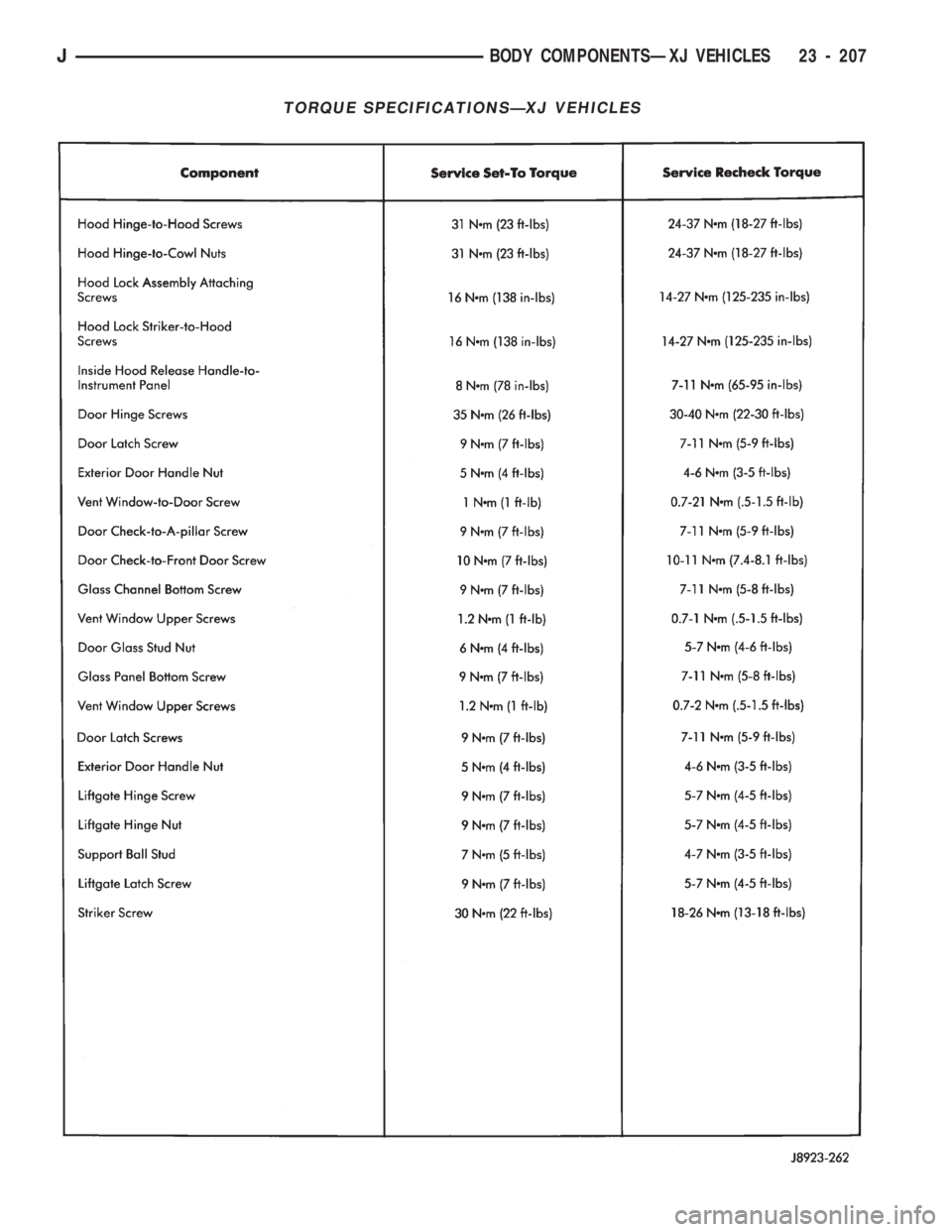
TORQUE SPECIFICATIONSÐXJ VEHICLES
JBODY COMPONENTSÐXJ VEHICLES 23 - 207